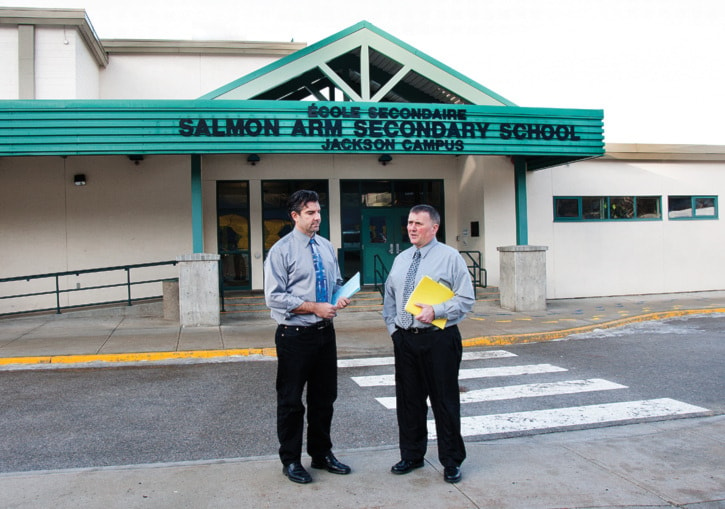Unwanted travelling between campuses by Salmon Arm Secondary students will be coming to a halt in September.
As the result of a process that began in January 2013, a decision has been made on how best to restructure the two-campus high school.
Out of the three options singled out during the process, a junior/senior model was the one that received “overwhelming” support from the community and stakeholders, said Reid Findlay, principal of the Jackson campus of SAS.
Added Rob MacAulay, principal of the Sullivan campus: “It was really good that the stakeholders were all on the same page, all the stakeholders had the same message. So we’re going in a direction the community feels good about or wants.”
With the new structure, grades nine and 10 would be primarily at Jackson while grades 11 and 12 would be primarily at Sullivan.
At a meeting on Nov. 5, Findlay and MacAulay had explained to parents and others that the three options being considered were: 1) a non-travelling model, where students from grades nine to 12 were at each campus and students were attached to a campus for the entire year; 2) a junior/senior model and 3) a ‘double block’ model.
Due to ensuing lack of support for the non-travelling model, just two options were then considered.
A main catalyst for considering restructuring was the fact the scheduling system wasn’t working. Because a computer program wasn’t available for the two-campus system, time-tabling was done manually. Students would return to have their schedules changed, often because of unhappiness with travelling between campuses.
“Rather than students travelling as they currently do between campuses, with the new structure they would only travel truly by choice, not by default,” Findlay said.
For example, chefs training and metal work are offered at Sullivan while woodworking is at Jackson. A student could choose to travel in order to take those specialities.
The new structure will continue to be two campuses and one school – not a junior and senior high.
“I would say nothing could be further from the truth,” responded Findlay to a question whether this is a return to an earlier model. “This is truly a made-in-Salmon Arm solution, how can we meet the needs of our kids from kindergarten to Grade 12.”
Both Reid and MacAulay refer to the notion of a Grade 10-and-a-half. It referred to a student who hadn’t quite passed all the requirements to be at the senior high school, so would get separated from their peer group.
That problem is now solved.
“There’s nothing to stop a student from taking a Grade 10 course in Grade 11, or vice versa. Whether it’s acceleration or deficiency, no one gets separated from their peers,” Findlay explained.
The Jackson campus was built in 1963 and renovations there were completed in 2003. Sullivan was constructed in 1997. The two-campus system was introduced eight years ago in conjunction with the creation of the middle school, which houses grades six through eight.
Although the Jackson building is less modern than Sullivan, Findlay said students’ ideas for change have been and will be incorporated.
From now until spring break, ‘innovation councils’ at both campuses will be looking at ways to introduce new ideas.
The double-block system received positive feedback during the restructuring process, so one possibility among many could be to offer some two-block classes, Findlay said.
“I can’t stress enough how much people have been looking forward to this stage, because it’s about learning and about what’s best for students. And that’s just invigorating for the entire system.”
